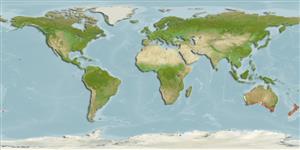Preferred temperature (Ref.
123201): 14.7 - 22.3, mean 17.8 °C (based on 132 cells).
Phylogenetic diversity index (Ref.
82804): PD
50 = 0.5000 [Uniqueness, from 0.5 = low to 2.0 = high].
Bayesian length-weight: a=0.01230 (0.00732 - 0.02067), b=3.04 (2.90 - 3.18), in cm total length, based on LWR estimates for this species & Genus-body shape (Ref.
93245).
Trophic level (Ref.
69278): 4.0 ±0.66 se; based on food items.
Widerstandsfähigkeit (Ref.
120179): mittel, Verdopplung der Population dauert 1,4 - 4,4 Jahre. (Preliminary K or Fecundity.).
Fishing Vulnerability (Ref.
59153): Low vulnerability (20 of 100).
Nutrients (Ref.
124155): Calcium = 48.4 [23.4, 103.2] mg/100g; Iron = 0.379 [0.204, 0.683] mg/100g; Protein = 18.5 [16.9, 20.0] %; Omega3 = 0.98 [0.42, 2.70] g/100g; Selenium = 9.57 [4.46, 22.24] μg/100g; VitaminA = 22.3 [7.7, 64.0] μg/100g; Zinc = 0.703 [0.497, 1.010] mg/100g (wet weight);
